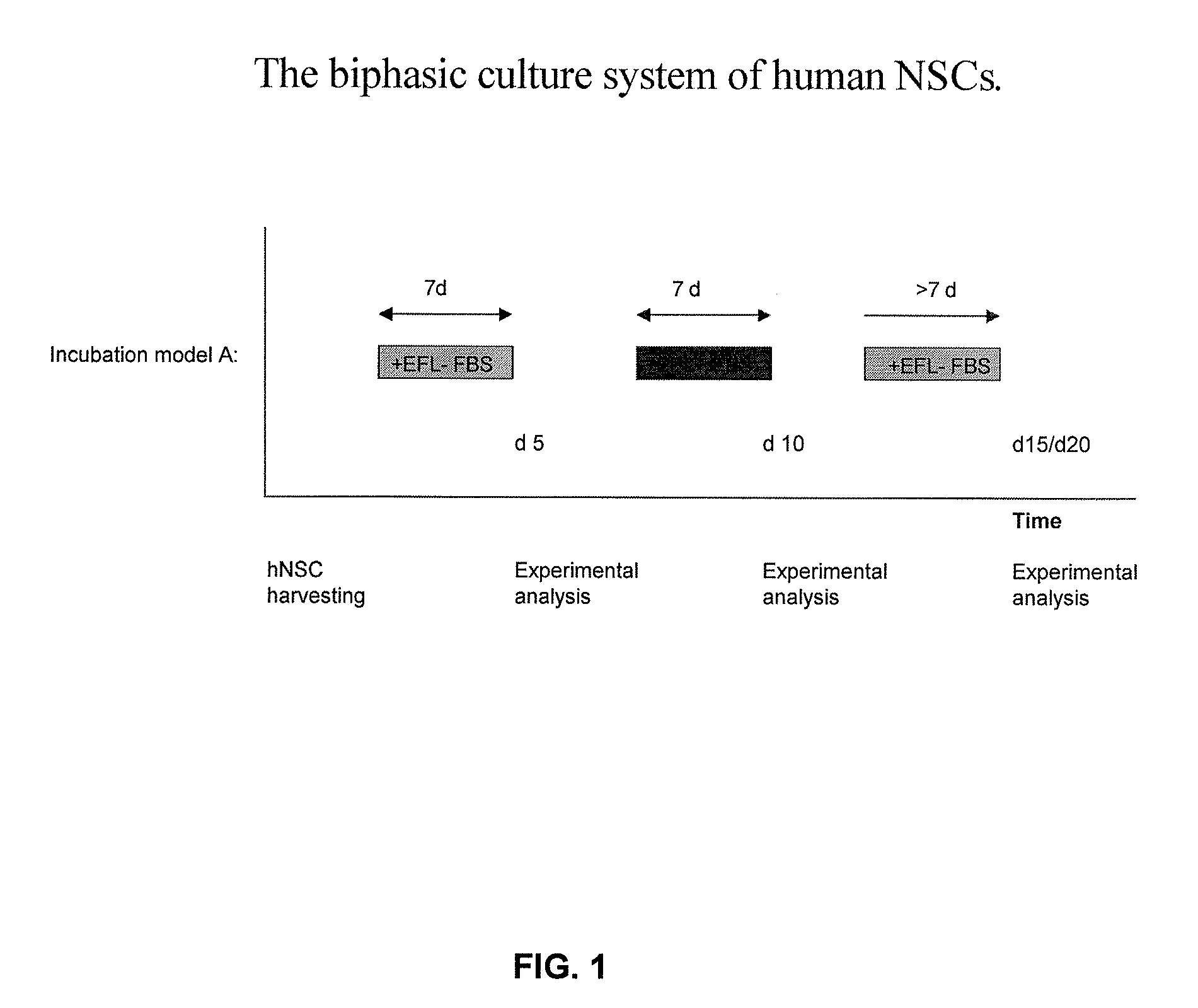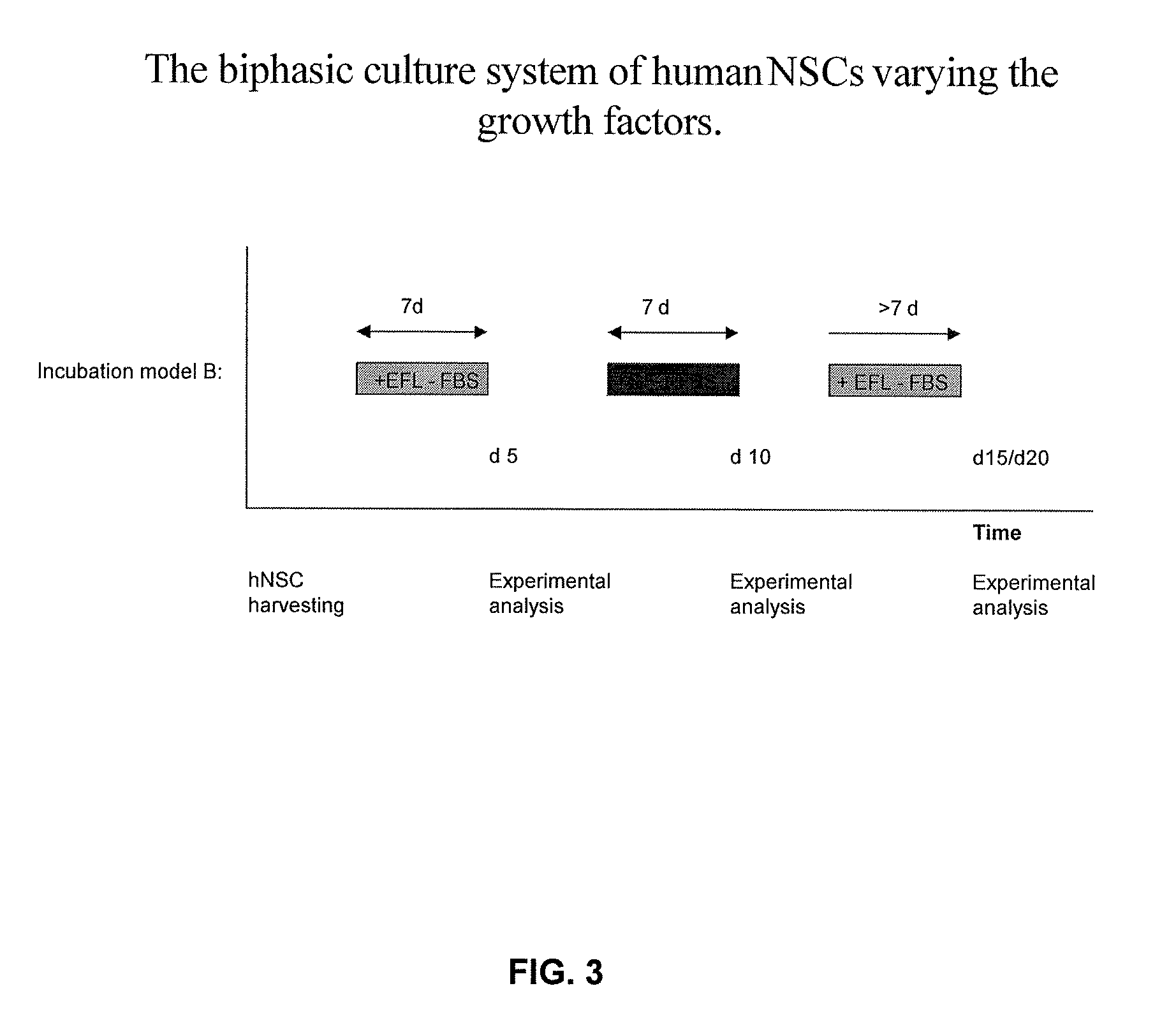Ex vivo progenitor and stem cell expansion and differentiation for use in the treatment of disease of the nervous system
a technology which is applied in the field of ex vivo progenitor and stem cell expansion and differentiation for use in the treatment of disease of the nervous system, can solve the problems of inability of the cns to regenerate, large number of multipotent cells, and time-consuming propagation of these stem cells, so as to reduce the rate of neuron degradation or neuron degradation
- Summary
- Abstract
- Description
- Claims
- Application Information
AI Technical Summary
Benefits of technology
Problems solved by technology
Method used
Image
Examples
example 1
Propagation of hNSC's
[0049]hNSCs were alternately cultured in the presence (EFL+FBS) or absence (EFL−FBS) of fetal bovine serum (see FIG. 1). The media change was carried out on days 7 and 14 after plating. Growth of the cells included initial incubation in EFL−FBS, followed by incubation in EFL+FBS. Experimental analysis of hNSCs was carried out on days 5, 10, 15, and 20, if not otherwise indicated. The following abbreviations were used to designate specific growth factors: E=EGF; F=bFGF; L=LIF.
[0050]Medium 1 (−FBS): DMEM / F12 (1:1), 2% B27 (Gibco), 1% Pen-Strep (PAA). EGF (20 ng / ml, Peprotech), bFGF (20 ng / ml, Peprotech), LIF (10 ng / ml, Chemicon), heparin (5 ug / ml, Sigma).
[0051]Medium 2 (+FBS): DMEM / F12 (1:1), 2% B27 (Gibco), 1% Pen-Strep (PAA), 1% FBS (Gibco), EGF (20 ng / ml, Peprotech), bFGF (20 ng / ml, Peprotech), LIF (10 ng / ml, Chemicon), heparin (5 ug / ml, Sigma).
[0052]After 10 days, cells were counted using a hemocytometer and 150,000 cells from all samples were seeded in new we...
example 2
Propagation of hNSC's
[0054]hNSC's were alternately cultured in media containing a certain growth factor and serum (GF+FBS) or in the media containing EFL but lacking the presence of fetal bovine serum (EFL−FBS) as shown in FIG. 3. The media was changed on days 7 and 14 after plating the cells. This example utilized an initial incubation in EFL−FBS, followed by incubation in media including FBS. Experimental analysis of hNSCs was carried out on days 5, 10, 15, and 20, if not otherwise indicated.
[0055]Human Neural stem cells were seeded at density of 100,000-150,000 cells / 200 mm2. Cells were grown alternately in 2 different conditions, each period lasting for 5 to 7 days. 10 to 14 days after plating, cells were counted and seeded to new plates at the same density (100,000-150,000 cells / 200 mm2).
[0056]Medium 1 (−GFs): DMEM / F12 (1:1), 2% B27 (Gibco), 1% Pen-Strep (PAA), EGF (20 ng / ml, Peprotech), bFGF (20 ng / ml, Peprotech), LIF (10 ng / ml, Chemicon), heparin (5 μg / ml, Sigma).
[0057]Medium...
example 3
Propagation of hNSC's
[0061]hNSC's were alternately cultured in media containing EGF or TGFα and bFGF and serum (E*F+FBS) or in media containing growth factors but lacking FBS (E*F−FBS) as shown in FIG. 5. Incubation mode C refers to initial incubation in E*F−FBS, followed by incubation in E*F+FBS. Experimental analysis of hNSCs was carried out on days 5, 10, 15, and 20, if not otherwise indicated. As a control, hNSC's were continuously grown in the absence of serum, but in the presence of growth factors EFL (control).
[0062]hNSC's were seeded at a density of 100,000-150,000 cells / 200 mm2. Cells were grown alternately in 2 different conditions, each period lasting for 5 to 7 days. 10 to 14 days after plating, cells were counted and seeded to new plates at the same density (100,000-150,000 cells / 200 mm2).
[0063]Medium 1 (−T, TE, E or C): DMEM / F12 (1:1), 2% B27 (Gibco), 1% Pen-Strep (PAA). EGF (20 ng / ml, Peprotech), bFGF (20 ng / ml, Peprotech), LIF (10 ng / ml, Chemicon), heparin (5 ug / ml, ...
PUM
| Property | Measurement | Unit |
|---|---|---|
| time | aaaaa | aaaaa |
| time | aaaaa | aaaaa |
| time | aaaaa | aaaaa |
Abstract
Description
Claims
Application Information
 Login to View More
Login to View More - R&D
- Intellectual Property
- Life Sciences
- Materials
- Tech Scout
- Unparalleled Data Quality
- Higher Quality Content
- 60% Fewer Hallucinations
Browse by: Latest US Patents, China's latest patents, Technical Efficacy Thesaurus, Application Domain, Technology Topic, Popular Technical Reports.
© 2025 PatSnap. All rights reserved.Legal|Privacy policy|Modern Slavery Act Transparency Statement|Sitemap|About US| Contact US: help@patsnap.com



